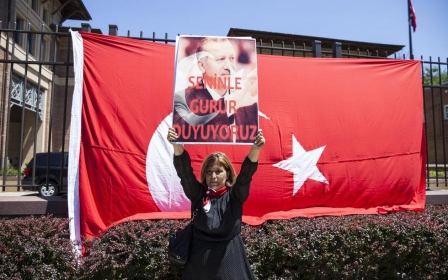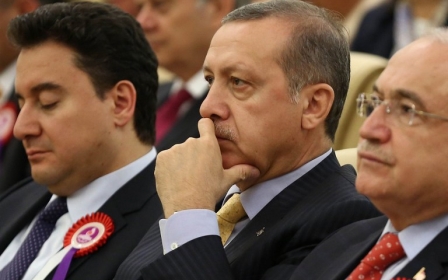Turkey nears goal of no-fly zone on Syria border

“This is just the beginning,” Turkey’s President Recep Tayyip Erdogan declared on Friday when announcing that his country will take an active part in the anti-Islamic State (IS) coalition and open its military airbases to the United States and other allied countries.
Though air strikes on Friday night were against six Kurdistan Workers’ Party (PKK) camps in northern Iraq, perhaps the most important message contained in the president’s message earlier in the day was that Turkey is now preparing to create no-fly and buffer zones along a key section of its border with Syria.
The Turkish media are speaking of a strip of airspace 90km long and 45km wide running westwards from Jarabulus. Syrian airforce jets straying into it face being shot down.
If, as the Turkish media are suggesting and President Erdogan hinted, the USA has agreed to the no-fly zone - something it was casting doubts upon only recently - it marks a breakthrough for Turkey in its confrontation with the Bashar al-Assad government in Syria. If the no-fly zone does come into being it will be a body blow for Assad and his supporters.
On 24 July, a State Department spokesman, Mark Toner, denied that it was “fair to describe what is happening as a no-fly zone,” and said he would not term it that. Instead the area is being dubbed an anti-IS zone.
Only five or six years ago, relations between Turkey and Syria were so close that the two countries even held join military exercises and no one could have imagined such a denouement. The rapprochement, coming after decades of a territorial dispute over the Turkish province of Antakya, was viewed uneasily from Washington which had long had strained relations with Damascus.
All that changed abruptly when the Arab Spring spread to Syria and the Assad government began brutally repressing protests against his rule. When Assad’s forces crushed protests in Jisr al-Shugour in June 2011, Erdogan publicly criticised the violence. "They are not acting in a humane manner. This is savagery," Erdogan said.
For a while Ankara hoped that it could use its good offices to achieve a solution to Syria’s internal problems. In August 2011, the Turkish and Syrian governments made a last-ditched effort to reach an agreement and fend off a civil war as groups in Syria pressed for democracy and greater human rights.
Turkish Prime Minister Ahmet Davutoglu, then Turkey’s foreign minister, flew to Damascus on 9 August 2011 and engaged in six hours of discussions with the Syrian government and left apparently believing that the two sides had reached agreement on a 14-point plan to end the incipient conflict.
Very soon after that meeting, however, the Syrian government burnt its bridges as far as Turkey was concerned by repudiating the deal. This was perhaps inevitable given the lopsided balance of religious and political communities in Syria and Assad’s power base among the minorities, but it implied a fight to the bitter end.
Dialogue between Turkey and its former friends in Damascus now ended. Seven months after Davutoglu’s 11th hour visit, diplomatic relations between the two countries were broken off and their embassies in Damascus and Ankara shut down.
Turkey, working with the US, Britain, and France, stepped up covert support for opposition Syrian groups fighting Assad, and Istanbul became the home to the exiled Syrian opposition leadership - though these faded from view over the next two years as the initiative passed to armed groups inside Syria such as Jabat al-Nusra and, from the spring of 2013 onwards, Islamic State now based in Raqqa, the first provincial capital to be captured by the opposition.
If a more moderate group had done this, the stage might have been set for the proclamation of an alternative government, opening the way for some international recognition. The existence of an opposition government could perhaps also have helped make possible the creation of a no-fly zone, which Turkey regarded as the essential instrument to bring down Assad by breaking the dominance in the skies of the Russian-supplied Syrian air force.
In the end, it was Syria which, perhaps inadvertently, shot down a Turkish airforce jet in June 2012. Despite the tensions, however, the Turkish response was restrained, confined to a little cross-border bombardment.
One consequence of the Syrian government’s air superiority was that an increasing number of the country’s population began fleeing for safety to neighbouring countries. Turkey, with a government which was both strongly sympathetic to the rebels and also possessed good infrastructure and a strong economy, became the main destination for the refugees.
By 2013, the trickle of refugees from Syria in Turkey, which began in the autumn of 2011 with about 7,500 of them, was turning into a flood.
Haven for refugees
Erdogan and the Turkish authorities saw - and still see - acceptance of the refugees as a humanitarian duty which they could not refuse. Turkey responded not only by setting up camps but by giving the new arrivals rights to medical insurance and allowing them to seek employment.
With the total number of refugees officially reckoned at 1.7 million last spring (though some observers put it nearer 2 million), they placed a strain on Turkey’s public finances.
The country has spent at least $6bn on Syrian refugees, who meanwhile have displaced many low-wage workers from their jobs in some communities, particularly along the border. Even so, flare-ups of ethnic tensions, though not unknown, have been relatively few.
Turkish officials recognise that many of the Syrians - having access not just to security but also to life in a more prosperous country - are unlikely ever to return home even if the war ends.
With parts of Syria still under Assad’s control - and a fierce struggle under way for Aleppo, the country’s second city, only 45km from the border with Turkey - whatever is being said openly at the moment, the future of Aleppo is likely to figure strongly in Turkish strategic thinking.
By finally agreeing, it seems, for the no-fly zone to be created, President Barack Obama may have finally opened the way for real changes in Syria after years of deadlock.
However, the prime target in the present circumstances is not Assad and his followers, but IS and the PKK. Assad may yet fall as a result of Turkey’s latest intervention but only if Turkey can successfully clear the proposed zone of IS fighters as it has said it is trying to do, and limit its confrontation with the PKK against which it has been fighting since 1984.
- David Barchard has worked in Turkey as a journalist, consultant, and university teacher. He writes regularly on Turkish society, politics, and history, and is currently finishing a book on the Ottoman Empire in the 19th century.
The views expressed in this article belong to the author and do not necessarily reflect the editorial policy of Middle East Eye.
Photo Credit: A military aircraft of Turkish Air Force lands at the Incirlik 10th Tanker Base Command in Saricam district, Adana on 24 July, 2015 (AFP)
Middle East Eye propose une couverture et une analyse indépendantes et incomparables du Moyen-Orient, de l’Afrique du Nord et d’autres régions du monde. Pour en savoir plus sur la reprise de ce contenu et les frais qui s’appliquent, veuillez remplir ce formulaire [en anglais]. Pour en savoir plus sur MEE, cliquez ici [en anglais].





